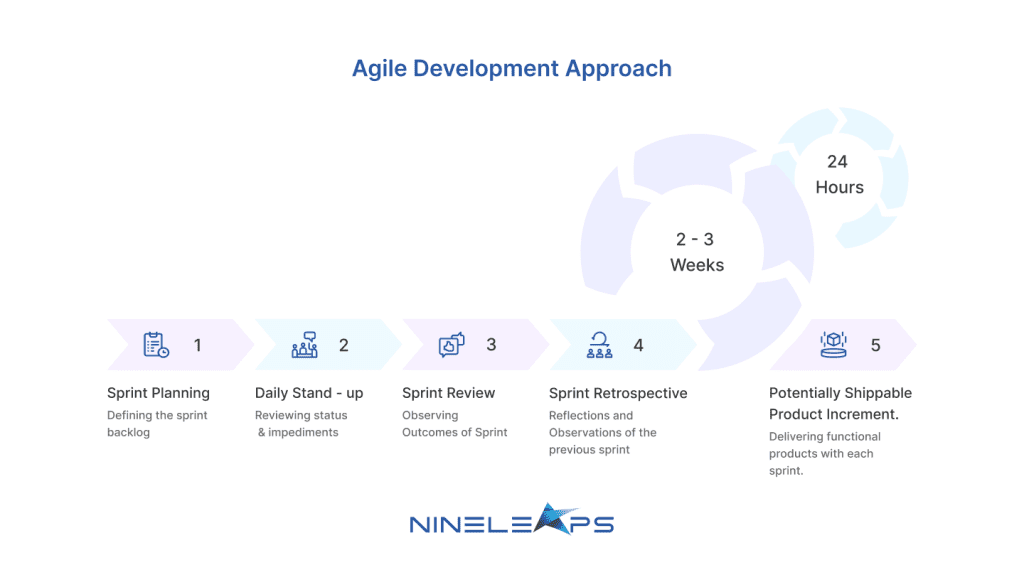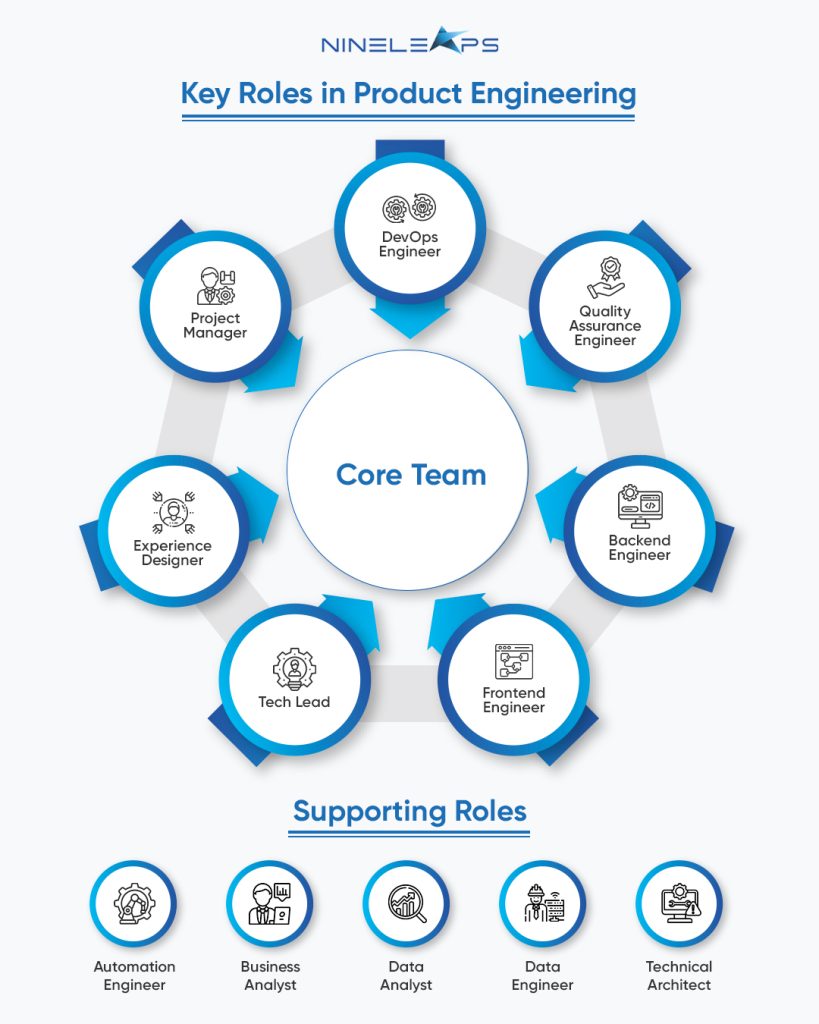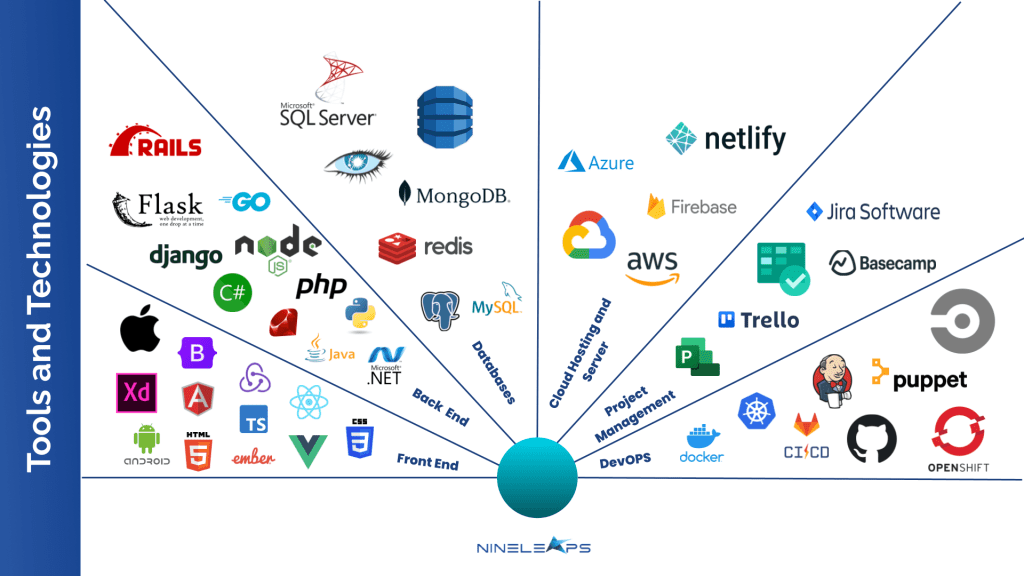Product engineering is the systematic approach to developing and maintaining software products. It involves various stages, including planning, designing, coding, testing, and deployment, aimed at delivering high-quality software solutions to meet specific user needs. In today’s digital age, software has become ubiquitous, driving innovation across industries. Understanding the nuances of product engineering is crucial for organizations aiming to stay competitive in the market.
Implementing Agile methodology offers numerous benefits, such as increased transparency, faster time-to-market, improved customer satisfaction, and higher quality products. However, it also presents challenges, including resistance to change, managing distributed teams, and maintaining alignment with business objectives.
Project Manager: As the central figure in the development process, the Project Manager coordinates all aspects of the project, from initial planning to final deployment. They define project scope, establish timelines, allocate resources, and manage risks to ensure successful project completion within budget and schedule constraints.
Experience Designer: This role focuses on crafting meaningful and intuitive user experiences by deeply understanding user needs, behaviors, and preferences. Experience Designers employ user research, wireframing, prototyping, and user testing to iteratively refine interfaces, ensuring that the software meets user expectations and drives engagement.
Tech Lead: Serving as the technical authority on the project, the Tech Lead oversees architectural decisions, sets coding standards, and guides the development team in implementing solutions that align with project goals and industry best practices. They are responsible for ensuring code quality, performance optimization, and scalability of the software.
Frontend Engineer: Frontend Engineers specialize in building the client-side components of the software, including user interfaces and interactions. They leverage their expertise in HTML, CSS, and JavaScript frameworks to create visually appealing and responsive interfaces that enhance user engagement and satisfaction.
Backend Engineer: Backend Engineers design, develop, and maintain the server-side logic and databases that power the software application. They focus on ensuring data integrity, security, and scalability while optimizing performance and responsiveness. Proficiency in programming languages like Python, Java, or Node.js is essential for this role.
Quality Assurance Engineer: QA Engineers play a critical role in maintaining the quality and reliability of the software by designing and executing comprehensive test plans. They identify and report defects, collaborate with developers to resolve issues, and ensure that the software meets functional and performance requirements. Automation testing frameworks and continuous integration tools are often utilized to streamline testing processes.
DevOps Engineer: DevOps Engineers bridge the gap between development and operations, focusing on automating and optimizing the software delivery pipeline. They configure deployment environments, manage infrastructure as code, and implement monitoring and logging solutions to ensure the reliability and scalability of the software in production environments. Continuous integration/continuous deployment (CI/CD) practices are central to their workflow.
Supporting Roles in a Product Engineering Team
Automation Engineer: Automation Engineers specialize in designing and implementing automated testing and deployment pipelines to accelerate the software development lifecycle. They develop scripts and tools to automate repetitive tasks, improve testing coverage, and enhance the reliability of software releases.
Business Analyst: Business Analysts act as intermediaries between stakeholders and the development team, translating business requirements into actionable specifications. They conduct market research, analyze user feedback, and prioritize features to maximize the value delivered by the software.
Data Analyst: Data Analysts gather and analyze data to extract actionable insights that inform decision-making and product development. They utilize statistical techniques, data visualization tools, and domain knowledge to uncover trends, patterns, and correlations in data sets.
Data Engineer: Data Engineers are responsible for designing, building, and maintaining data pipelines that facilitate the collection, storage, and processing of large volumes of data. They ensure data quality, integrity, and accessibility while optimizing data infrastructure for performance and scalability.
Technical Architect: Technical Architects define the overall structure and design of the software system, considering factors such as scalability, security, and maintainability. They guide technology selection, system integration, and architectural patterns to ensure that the software meets both current and future requirements.
Common Technologies in Product Engineering
Product engineers leverage a plethora of technologies to design, develop, and maintain software products across various domains. These technologies enable efficient collaboration, streamline development processes, and ensure the delivery of robust and innovative solutions. Some of the common technologies employed by product engineers include:

Programming Languages: Product engineers utilize programming languages such as JavaScript, Python, Java, C#, and Ruby to implement the logic and functionality of software applications. Each language offers unique strengths and is selected based on project requirements, performance considerations, and team expertise.
Frameworks and Libraries: Frameworks and libraries provide pre-built components and abstractions that expedite development and enhance code quality. Popular frameworks and libraries include React.js, Angular, Vue.js for frontend development, Django, Flask for backend development, and TensorFlow, and PyTorch for machine learning applications.
Version Control Systems: Version control systems such as Git enable product engineers to track changes, collaborate effectively, and manage codebase history. Git, coupled with platforms like GitHub, GitLab, or Bitbucket, facilitates seamless code collaboration, code review, and continuous integration workflows.
Integrated Development Environments (IDEs): IDEs like Visual Studio Code, IntelliJ IDEA, and PyCharm provide feature-rich environments for writing, debugging, and testing code. These tools offer syntax highlighting, code completion, debugging tools, and integrations with version control systems, enhancing developer productivity.
Containerization and Orchestration: Containerization technologies like Docker enable product engineers to package applications and their dependencies into portable containers, ensuring consistency across development, testing, and production environments. Orchestration platforms like Kubernetes facilitate efficient deployment, scaling, and management of containerized applications in distributed environments.
Cloud Platforms: Cloud platforms such as Amazon Web Services (AWS), Microsoft Azure, and Google Cloud Platform (GCP) offer scalable infrastructure and services that empower product engineers to build, deploy, and manage applications with ease. Services like AWS Lambda, Azure Functions, and Google Cloud Functions enable serverless computing, while offerings like AWS Elastic Beanstalk, Azure App Service, and Google App Engine simplify application deployment and management.
Database Technologies: Product engineers leverage various database technologies to store, retrieve, and manage data effectively. Relational databases like MySQL, PostgreSQL, and SQL Server are commonly used for structured data storage, while NoSQL databases like MongoDB, Cassandra, and Redis are preferred for handling unstructured and semi-structured data.
Testing and Quality Assurance Tools: Testing and quality assurance tools are essential for ensuring the reliability and functionality of software products. Tools like Selenium, Jest, and pytest facilitate automated testing, while continuous integration platforms like Jenkins, Travis CI, and CircleCI automate the build, test, and deployment processes, ensuring code quality and stability.
Monitoring and Logging Solutions: Monitoring and logging solutions such as Prometheus, Grafana, ELK Stack (Elasticsearch, Logstash, Kibana), and Splunk enable product engineers to monitor application performance, troubleshoot issues, and gain insights into system behavior. These tools help identify bottlenecks, detect anomalies, and ensure the reliability and scalability of software products.
Collaboration and Communication Tools: Collaboration and communication tools like Slack, Microsoft Teams, Jira, and Confluence facilitate seamless communication, task management, and collaboration among product engineering teams. These tools streamline project coordination, foster transparency, and enhance team productivity by centralizing communication and project documentation.
User Experience (UX) Design in Product Engineering
Importance of UX Design in Product Engineering
User Experience (UX) design is essential for creating intuitive and engaging software products that resonate with users. It focuses on understanding user behaviors, preferences, and pain points to design interfaces that are visually appealing, functional, and easy to navigate. Investing in UX design enhances user satisfaction, drives adoption, and fosters brand loyalty.
UX Design Process
The UX design process involves several stages, including user research, wireframing, prototyping, usability testing, and iteration. Designers collaborate with stakeholders and end-users to gather insights, define requirements, and iteratively refine the user interface based on feedback. By following a user-centric approach, organizations can create products that deliver exceptional user experiences.
Testing and Quality Assurance in Product Engineering
Types of Testing
Software testing encompasses various techniques and methodologies to validate the functionality, performance, and security of software products. Common types of testing include unit testing, integration testing, system testing, acceptance testing, and security testing. Each type serves a specific purpose in identifying defects and ensuring product quality throughout the development lifecycle.
Importance of QA
Quality Assurance (QA) is paramount in product engineering to detect and rectify defects before they impact end-users. QA processes involve systematic testing, defect tracking, and continuous improvement to uphold product standards and meet customer expectations. By investing in robust QA practices, organizations can mitigate risks, enhance product reliability, and maintain user satisfaction.
DevOps Practices in Product Engineering
Continuous Integration and Deployment (CI/CD)
DevOps practices aim to streamline the software delivery process by automating build, test, and deployment pipelines. Continuous Integration (CI) involves merging code changes into a shared repository and running automated tests to detect integration issues early. Continuous Deployment (CD) automates the release process, enabling frequent and reliable software deployments to production environments.
Automation in DevOps
Automation plays a pivotal role in DevOps, enabling teams to accelerate development cycles, improve efficiency, and reduce errors. DevOps automation encompasses various aspects, including infrastructure provisioning, configuration management, testing, and deployment. By embracing automation tools and practices, organizations can achieve greater agility and responsiveness in software delivery.
Security in Product Engineering
Importance of Security Measures
Security is a critical aspect of product engineering, safeguarding sensitive data, systems, and users from cyber threats and vulnerabilities. Implementing robust security measures, such as encryption, access controls, and vulnerability scanning, is essential to mitigate risks and ensure compliance with regulatory requirements.
Common Security Threats
Software products face various security threats, including malware, phishing attacks, data breaches, and denial-of-service (DoS) attacks. These threats can compromise confidentiality, integrity, and availability, posing significant risks to organizations and their stakeholders. Addressing security threats requires a proactive approach, incorporating security best practices and leveraging advanced security technologies.
Scalability and Performance Optimization
Scaling Techniques
Scalability is essential for accommodating growing user demands and maintaining optimal performance under increasing workload. Scalability techniques, such as horizontal scaling, vertical scaling, and load balancing, enable systems to handle higher traffic volumes and scale resources dynamically based on demand.
Performance Optimization Strategies
Performance optimization focuses on enhancing the speed, responsiveness, and efficiency of software applications. Strategies for performance optimization include code optimization, caching, database tuning, and network optimization. By identifying performance bottlenecks and implementing optimization techniques, organizations can deliver faster and more responsive user experiences.
Documentation and Maintenance
Importance of Documentation in Product Engineering
Documentation is critical for ensuring the clarity, consistency, and maintainability of software products. It provides comprehensive guidance on system architecture, design decisions, APIs, and user interfaces, facilitating development, troubleshooting, and knowledge transfer. Well-documented software promotes collaboration, reduces dependencies, and accelerates onboarding for new team members.
Maintenance Best Practices
Software maintenance encompasses activities aimed at preserving the functionality, stability, and security of software products over time. Best practices for maintenance include regular updates, patch management, bug fixes, and performance monitoring. By proactively addressing maintenance needs, organizations can extend the lifespan of their software assets and optimize their long-term value.
Client Collaboration and Feedback Loop
Importance of Client Involvement in Product Engineering
Client collaboration is essential for aligning software development efforts with customer needs and expectations. Engaging clients throughout the development process enables teams to gather feedback, validate assumptions, and prioritize features effectively. By fostering a collaborative partnership with clients, organizations can ensure the successful delivery of software products that meet business objectives.
Feedback Loop Mechanisms
Establishing feedback loop mechanisms enables continuous improvement and iterative refinement of software products based on user input. Feedback can be collected through various channels, such as surveys, user interviews, beta testing, and analytics. By soliciting and acting upon feedback, organizations can enhance product usability, address user pain points, and drive innovation.
Common Product Engineering Use Cases
Software product engineering encompasses a wide range of use cases, each serving diverse industries and purposes. Some notable examples include:
Web and Mobile Applications: Utilizing product engineering, teams can design, develop, test, and maintain web and mobile applications tailored for various sectors such as e-commerce, communication, social networking, and healthcare.
Enterprise Software: Catering to organizational needs, product engineering facilitates the creation, development, and maintenance of enterprise software solutions. These encompass essential systems like enterprise resource planning (ERP), customer relationship management (CRM), and supply chain management (SCM) platforms.
Internet of Things (IoT): In the realm of IoT, product engineering enables the design and implementation of software solutions for interconnected devices and systems. Applications span from smart home setups and industrial automation to retail inventory management and connected vehicle systems.
Gaming: Software product engineering is pivotal in the creation, testing, and upkeep of video games across diverse platforms including PCs, gaming consoles, and mobile devices.
Artificial Intelligence and Machine Learning (AI/ML): Within AI and ML domains, product engineering plays a crucial role in developing AI and ML-based applications such as chatbots, predictive models, and autonomous systems.
Embedded Systems: For embedded systems where computing capabilities are integrated into devices, product engineering facilitates applications across automotive systems, medical devices, and industrial control systems, ensuring seamless functionality.
Cybersecurity: In the realm of cybersecurity, product engineering is instrumental in developing protective measures such as firewalls, intrusion detection systems, and encryption software to safeguard digital assets and systems against threats.
Emerging Technologies
Emerging technologies, such as artificial intelligence, machine learning, blockchain, and Internet of Things (IoT), are reshaping the landscape of product engineering. These technologies offer new opportunities for innovation, efficiency, and differentiation, enabling organizations to create smarter, more connected, and more personalized software solutions.
Predictions for the Future
The future of product engineering holds immense promise, driven by advancements in technology, evolving customer expectations, and changing market dynamics. Key trends shaping the future include the rise of cloud-native architectures, the proliferation of low-code development platforms, the integration of AI-driven capabilities, and the increasing focus on cybersecurity and privacy.
In conclusion, demystifying product engineering requires a deep understanding of its core principles, methodologies, and best practices. By embracing Agile methodologies, leveraging cutting-edge technologies, and prioritizing customer-centricity, organizations can navigate the complexities of software development and deliver innovative solutions that drive business growth and competitive advantage.






